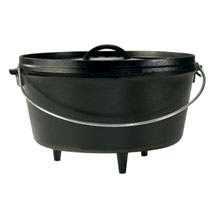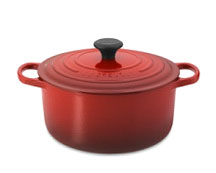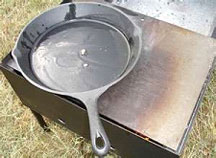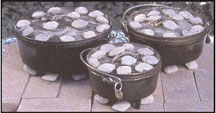Patty's Preparedness Corner: The "Skinny" on Dutch Oven Cooking
By Patty Liston
 Let me admit from the outset that I am NOT an experienced Dutch oven cook. While I have experimented with it, I have mostly been the happy recipient of other people's expertise. Some of the best rolls, desserts, soups and chicken dishes have come from a Dutch oven that has been surrounded by hot charcoal briquettes for several hours.
Let me admit from the outset that I am NOT an experienced Dutch oven cook. While I have experimented with it, I have mostly been the happy recipient of other people's expertise. Some of the best rolls, desserts, soups and chicken dishes have come from a Dutch oven that has been surrounded by hot charcoal briquettes for several hours.
 True to my belief that I should not be asking you to do or try something I am not doing myself, becoming more proficient in cooking with my trusty, black Dutch oven, is something I AM going to do. Thanks to the Cook'n cookbooks, Dutch Oven and Other Camp Cookin' and Ethnic & Regional Dutch Oven Cookin', you and I will have over 480 recipes to experiment with!
True to my belief that I should not be asking you to do or try something I am not doing myself, becoming more proficient in cooking with my trusty, black Dutch oven, is something I AM going to do. Thanks to the Cook'n cookbooks, Dutch Oven and Other Camp Cookin' and Ethnic & Regional Dutch Oven Cookin', you and I will have over 480 recipes to experiment with!
As part of our preparedness schooling, learning how to use one of these ovens will be vital if we are ever without electricity for an extended period of time. Just by using briquettes, we would be able to provide nutritious, hot meals for our family.
What is a Dutch Oven?
 As shown to the right, a Dutch oven is a thick-walled (usually cast iron) cooking pot with a tight-fitting lid. They can be purchased at camping supply stores, discount stores, and kitchen stores. Most, like the rustic one shown above, can be purchased for prices starting at around $30.
As shown to the right, a Dutch oven is a thick-walled (usually cast iron) cooking pot with a tight-fitting lid. They can be purchased at camping supply stores, discount stores, and kitchen stores. Most, like the rustic one shown above, can be purchased for prices starting at around $30.
 This enamel version by Williams Sonoma will cost you a hefty $265 and up.
This enamel version by Williams Sonoma will cost you a hefty $265 and up.
Seasoning Your Oven
 Most cooks will season their cast iron after purchasing. This is done by boiling water and cleaning your pot or pan with a brush - no soap added. After it has dried thoroughly, coat the inside with a thin layer of cooking oil (saturated fats preferred to polyunsaturated), to prevent it from rusting.
Most cooks will season their cast iron after purchasing. This is done by boiling water and cleaning your pot or pan with a brush - no soap added. After it has dried thoroughly, coat the inside with a thin layer of cooking oil (saturated fats preferred to polyunsaturated), to prevent it from rusting.
Store your oven in a dry location with the lid ajar or off to ensure air circulation.
Seasoned (no pun intended), Dutch oven cooks will tell you that a well-worn oven will become a dark black color and very smooth and shiny. The seasonings over years of use seem to add to the flavor of whatever you are cooking. I have one friend whose oven belonged to her grandmother. Yes, your investment will last that long!
Temperature control for baking:
Most baking recipes require a temperature setting of 325 degrees F. An easy method to get a temperature of 325 degrees Fahrenheit within your Dutch oven is to:
Subtract the number 3 from the size of your oven in order to know how many briquettes to add underneath it
Add the number 3 to the size of your Dutch oven to determine the number of charcoal briquettes to put on the lid
One-third of the heat will be underneath the Dutch oven, and two-thirds of the heat will be on top. Heat rises, so you do not need as many coals on the bottom of the oven.
 (To find the size of your Dutch oven in order to determine the amount of briquettes to use, look at the lid. The numbers will be imprinted on the top of the lid as shown above, 12 inches, or underneath the lid).
(To find the size of your Dutch oven in order to determine the amount of briquettes to use, look at the lid. The numbers will be imprinted on the top of the lid as shown above, 12 inches, or underneath the lid).
For an example, the following numbers are for baking in a 12 inch Dutch Oven at a 325 degrees Temperature
Subtract 3 from 12, which equals 9 - the number of briquettes to place beneath the oven.
Add 3 to 12 which equals 15 - the number of briquettes to place on the lid of the oven.
 Using the above formula, here are some other numbers of briquettes to use, for the various sizes of ovens offered:
Using the above formula, here are some other numbers of briquettes to use, for the various sizes of ovens offered:
8 in= 11, 5
10 in= 13, 7
12 in, (our example) = 15, 9
14 in= 17, 11
16 in= 19, 13
Arranging the Briquettes
 Arrange briquettes so they are evenly spaced under the Dutch oven and on its lid. Also, you always need to rotate your Dutch oven a quarter turn every 15 minutes to avoid hot spots. Replace briquettes with new coals as they burn out.
Arrange briquettes so they are evenly spaced under the Dutch oven and on its lid. Also, you always need to rotate your Dutch oven a quarter turn every 15 minutes to avoid hot spots. Replace briquettes with new coals as they burn out.

